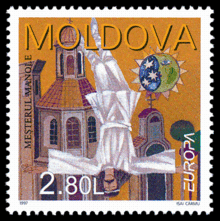- Meșterul Manole
-
In Romanian mythology, Meșterul Manole (roughly: The master builder Manole) was the chief architect of the Curtea de Argeș Monastery in Wallachia. The myth of the cathedral's construction is expressed in the folk poem Monastirea Argeșului ("The Monastery on the Argeș River").
Contents
Plot
The Legend of Master Manole: Negru Voda wanted to build the most beautiful monastery in the country so he hired Master Manole, the best mason of those times, along with his 9 men. Because the walls of the monastery were always crumbling, the prince threatened him and his assistants with death.
Manole had a dream in which he was told that, in order to build the most beautiful monastery, he had to wall in someone very beloved by him or by his masons. He told his masons about it and they agreed that the first wife who came there on the following morning should be the victim.
Manole`s wife, Ana (who was pregnant) came first and she was told that they wanted to play a little game, building walls around her. She accepted and soon realized that it wasn`t a game and implored Manole to let her go, but he kept his promise. Thus the beautiful monastery was built.
When Manole and his masons told the prince that they could always build an even greater building, Radu Negru had them stranded on the roof so that they could not build something to match it. They fashioned wooden wings and tried to fly off the roof, but, one by one, they all fell to the ground. A spring of clear water, called after Manole, is said mark the spot where Manole fell.
Negru Vodă
Negru-Vodă from the tale appears to be a fusion between Radu Negru, the traditional founder of Ţara Românească (Wallachia), and Neagoe Basarab, the historical builder of the church.
Legacy and similarities
Many Romanian writers had this motif as source of inspiration. Among them, Lucian Blaga (in his Meşterul Manole theatre play) brought forth a modern take on the myth. In Blaga's version, Manole's self-sacrifice is not prompted by any gesture of Prince Radu, being instead seen as a personal journey. A similar tale in Hungarian culture is Kőműves Kelemen ("Kelemen, the Bricklayer"), whose synopsis is essentially equivalent to the story of Manole. Similar stories exist in Inner Mongolia (related to the Hunnic city of Tongwancheng) and in the Southern Balkans, in Serbia, Montenegro, Bulgaria, and Greece (the Bridge of Arta).
External links
Categories:- Romanian mythology
Wikimedia Foundation. 2010.

